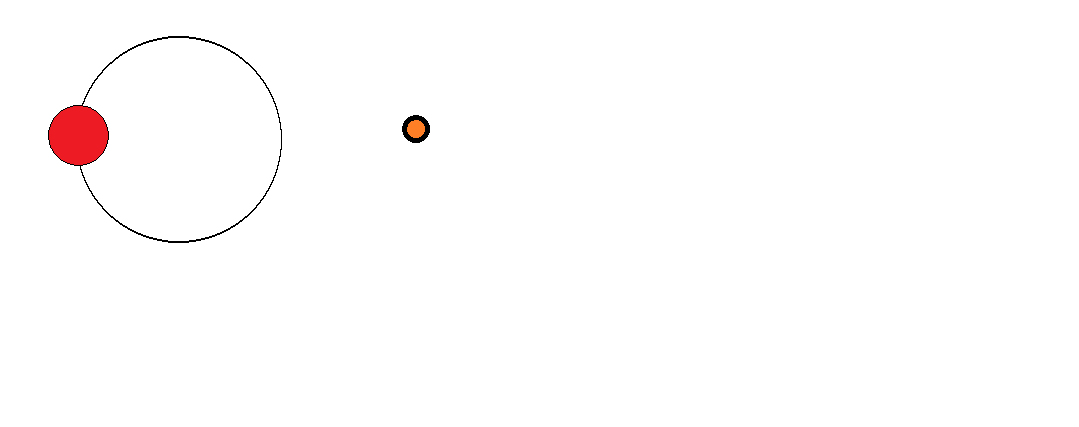Geometry + Kinematics Challenge
 Consider the following gif (animation),
Consider the following gif (animation),
As seen from ground, the Orange ball is static whereas the Red Ball rotates about a fixed point and Also About itself (which has not been shown in animation) clock wise in both cases
Now suppose that it rotates about itself at w 1 and rotates about the centre of the circle at w 2 , Let the minimum distance between the two balls is D − R and the radius of the circle be R.
Then as seen by the moving ball or in the reference frame attached with the moving ball that also rotates along with it about itself,
The trajectory of the stationary ball can be written as the equation of a Conic, then the eccentricity can be written as
b a
Then find 3 5 − ( a + b )
Note:
1)
D
=
3
,
w
2
=
1
0
,
w
1
=
5
,
R
=
2
All are in SI units.
2)
a
,
b
are all positive and real integers
3) The origin of the coordinate system in moving reference frame is the Red Ball itself
The answer is 6.
This section requires Javascript.
You are seeing this because something didn't load right. We suggest you, (a) try
refreshing the page, (b) enabling javascript if it is disabled on your browser and,
finally, (c)
loading the
non-javascript version of this page
. We're sorry about the hassle.
1 solution
Wonderful, Thanks for taking the time to post such a clear diagram with solution,
Actually, my way is different, i used superposition as follows
First, let us consider the frame which moves with the ball but doesnt rotate along with it about itself, in this frame
The motion of orange ball is simply a circle with centre at x = D with same radius R and same w = 1 0 , Let us call the centre x = D as C
, now upon it let us super pose the motion of rotation about the origin,
Then what we have is that the C now rotates about the Orange ball at 5 rad per sec and the particle rotates about C at 10 rad / sec
The location of C at any instant can be given as 3 e i 5 t
now, about C , the position of the particle can be given as ( − 2 c o s ( 1 0 t ) , 2 s i n ( 1 0 t ) )
where the angle is with the line joining orange ball with C , but we need line joining the x-axis of orange ball,
so we subtract that angle to get (last time, i forgot to subtract and account for this, hence wrong answer came)
d i s p l a y s t y l e ( − 2 c o s ( 1 0 − 5 ) t , 2 s i n ( 1 0 − 5 ) t )
= ( − 2 c o s ( 5 t ) , 2 s i n ( 5 t ) )
now superposing motion we have
( x , y ) = ( 3 c o s ( 5 t ) − 2 c o s ( 5 t ) , 3 s i n ( 5 t ) + 2 s i n ( 5 t ) )
or simply ( c o s ( 5 t ) , 5 s i n ( 5 t ) )
but yours is way simpler exploiting conis method
Log in to reply
That is a good way to do it. Never occurred to me though.
Log in to reply
done, check now
Log in to reply
@Mvs Saketh – Don't say ellipse! We can still do it! Say it is a conic, and then give eccentricity. And it should be 35-(a+b).
Log in to reply
@Raghav Vaidyanathan – Yes i have written its a conic,
see this
e = 1 − 5 2 1 2 = 6 2 4
so 3 5 − ( a + b ) = 6
yep sorry @Raghav Vaidyanathan
@Mvs Saketh – @Mvs Saketh If i may make a suggestion, edit question to find area of trajectory. And then manipulate trajectory area to give 6 . You can even use floor function. 0 . 4 A r e a
The initial position and the initial coordinate axes of the red ball is given in green. The new coordinate axes are in blue.
The complex no. associated with C is C − P = C = − R e i ( w 1 − w 2 ) t
By rotating vectors, we get:
D O − C = R − ( C − P ) e i w 2 t = R R e i ( w 1 − w 2 ) t e i w 2 t ⇒ O − C = D e i w 1 t ⇒ O − P = O = D e i w 1 t − R e i ( w 1 − w 2 ) t
Putting in the given values, the answer is cos 5 t + ( 5 sin 5 t ) i
Which is an ellipse of eccentricity 2 4 / 5 , thus, the answer is 3 5 − ( 2 4 + 5 ) = 6
edit: There is a flaw in the way the quation has been asked. Since we know that the trajectory is an ellipse, the required answer is simply sum of minimum and maximum distances from rotating ball, which directly gives answer as 6 . Classic Jee style. Please do something about this @Mvs Saketh but please dont delete it again. It took me a while to write solution.